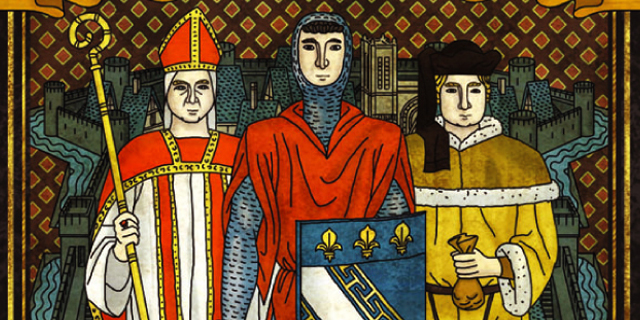
Troyes, published in the U.S. by Z-Man Games, puts players in the position of medieval French nobility over a stretch of four centuries as they attempt to complete their cathedral, despite numerous interruptions by marauders and other outside forces. By exerting influence over the military, clergy, and peasants, players try to accumulate the most fame for their family while seeking the admiration of several important characters.
Each player (from two to four) begins with five deniers, four influence, four citizens (meeples), and one secret character card (in a two-player game each player receives two characters); this character will reward all players who meet its criteria at the end of the game, so figuring out the identities of the other players’ characters can be key. The number of rounds is determined by the number of players; set aside that many red Event cards, one of which will be revealed each round, along with a corresponding yellow or white Event card as indicated. The various spaces around the board are filled with randomly chosen activity cards that will also be revealed once a round for the first three rounds. Play begins with players placing the citizens on one of the three buildings (Palace, Bishopric, or City Hall) in order to assemble a work force (dice). Unclaimed spaces are occupied by neutral citizens.
Each round begins (after revealing the appropriate activity cards, if any) by each player receiving an income of ten deniers. Each citizen in a building bestows one corresponding die to its player, which must be funded; red dice cost two deniers and white dice cost one (yellow dice are free). Inability to pay for your work force results in a loss of 2 VP. Each player’s dice are then rolled and placed in their respective district on the board; the remaining dice are then rolled by the current first player and placed in the neutral district. Then the round’s Event cards are revealed, creating a series of hardships for the players that are then executed. Some of these hardships will involve black dice, which are rolled by the start player and must be dealt with before any normal actions are taken. Each player, in turn, must commit dice from his/her work force in order to dispatch at least the highest-valued black die before passing; red dice are worth twice their value for dispatching black dice, and players may eliminate more than one die if they wish, with each die being worth one influence as a reward. If a player cannot combat the die assigned to him/her, then they lose 2 VP and that die is discarded with no reward.
Once the enemy dice have been dealt with, players may take actions. There are five general actions, with several choices within a few of those options: 1) activate an Activity card (various effects); 2) construct the Cathedral (there are three levels, and you can’t construct a higher level unless the corresponding lower levels have been built — note that there is a 2VP penalty at the end of the game for each level you haven’t helped to build); 3) combat the Events (this will gain you influence and VP as well as reducing the hardships in future rounds); 4) place a citizen in a Principal Building (this may earn you more dice in future rounds, but will probably free up a citizen for someone else); or 5) use Agriculture (generate cash with yellow dice).
Each action uses from one to three dice, and dice may be purchased from other players (and/or the neutral district) — but the price increases according to the total number of dice being used for the action. Most activities indicate a color of die over a number; the number of times the combined value of your assigned group of dice can be divided by that number is how many times you can execute that activity on that action. Some actions also require a citizen to be placed (on either an activity card or a building); players with no citizens in reserve must either spend two influence points to acquire a new one from their supply or move an already existing citizen. Influence can also be spent to reroll a die in your district (one point) or to flip from one to three of your own dice to their opposite face (four points). A player may also pass by taking two deniers from the bank and placing them in his/her district; each time the action comes back to a player who has already passed, one additional denier is added to their district. The round is over once either all players have passed or no dice remain in the districts; either way all players who have passed then collect the deniers that have accumulated in their districts.
The variety of events and activities is what gives Troyes much of its charm, but makes it kind of a pain to describe and explain. It also makes initial plays a little overwhelming, especially as players will have to constantly check the reference sheet to remember what each card does; the cards themselves feature no important text, only symbols that will eventually become familiar through several plays. Being able to purchase dice from your opponents can also deny them crucial options at the cost of a few deniers — if you can afford the price.
There are often so many choices that analysis paralysis can be a factor, especially if one of your opponents just stole one of your dice that you were planning to use! A game of Troyes is playable in around 90 minutes as a result, but games will frequently stretch beyond the 100-minute mark as a result of these issues. Still, the strategic depth is more than worth that time investment, even if the randomness (ironically not from the dice, but from the unknown selection of activities and events) makes advanced planning difficult or impossible.



















